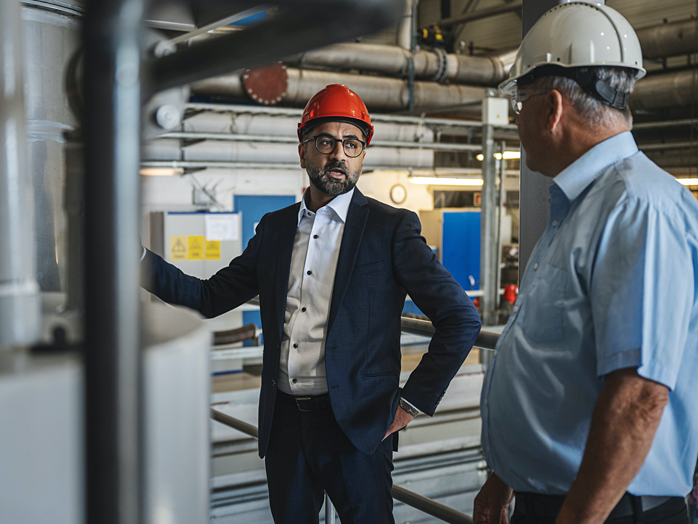
Op-Ed: Technology crucial in tackling shipping’s sustainability challenge
Written by Heather Ervin
Kashif Javaid (left). (Credit: Wartsila)
By Kashif Javaid, Director of Sales, Wärtsilä Exhaust Treatment
When scrubbers were first implemented en masse for the International Maritime Organization’s Global Sulfur Cap, little was discussed on their potential to be upgraded to tackle the biggest maritime sustainability challenge of all—carbon. However, recent evidence shows that scrubbers as a technology platform around the stack have created the perfect incubator for other environmental technologies, says Javaid
When we think about the momentous challenge of improving maritime sustainability, and especially of decarbonizing, it’s clear that technologies will have a critical role to play in driving real change.
Simultaneously, it’s also clear that no two owners’ decarbonization pathways will be alike, so it’s a requirement that technology providers and innovators must cast a wide net and develop solutions that are modular, flexible, and scalable. Equally, these innovations must meet shipyard and customer expectations on cost, size, and installation time, as well as consider shipping’s highly segmented, commoditized, and fragmented marketplace. All these factors will be crucial for increasing timely adoption across the global fleet.
There is also the problem of asset lifespans, with technology decisions today potentially having ramifications beyond when more stringent decarbonization targets will come into force Taking a life cycle approach to innovation is therefore necessary, otherwise ship owners face unnecessary costs and delays, and ultimately risk being left with stranded assets.
Opting for a truly future-proof and assured technology option now is critical for meeting impending regulations, while also paving the way for further decarbonization progress as regulations evolve over the next few decades.
A Perfectly Placed Solution
Every indication is that scrubbers fit these requirements. They already provide a more environmentally friendly life cycle choice compared to other compliant fuels, including very low sulfur fuel oil (VLSFO), for meeting IMO 2020 and Emission Control Area requirements.
However, beyond their role as a solution for sulfur emissions, scrubbers are perfectly placed to help the industry’s wider environmental transition. Considering that the shipping industry is responsible for 15% of the world’s NOx emissions, 14% of the world’s SOx emissions, a significant share of the world’s particulate matter (PM) emissions, and around 2.5% of the world’s CO2 emissions, they offer the potential for future-proof compliance on many fronts.
Now, advancements in exhaust gas treatment technologies allow for solutions to be incorporated around the stack that are smaller, lighter, and more suited to individual ship requirements. These new technologies work together in the stack and across the propulsion chain to tackle a range of different emitted substances including NOx reduction with exhaust gas re-circulation (EGR) systems. By using scrubbers as a platform, the industry gains access to a cost-efficient way of both reaching Tier III compliance, as well as a solution to reduce particulate matter.
A Vital Tool for Reducing CO2
Next in line is carbon capture and storage (CCS). In the very near future, developments in exhaust gas abatement technologies will enable shipping to capture carbon at the point of exhaust. For example, together with Norwegian shipping company Solvang ASA, Wärtsilä Exhaust Treatment is already due to undertake a full-scale pilot retrofit installation of a CCS system on one of Solvang’s ethylene carriers, the 21,000 cbm Clipper Eos. The project is supported by the vessel’s charterer Marubeni Corporation, and the installation is expected to be completed in 2023.
CCS technologies could initially enable around 70% reduction in CO2 emissions at the point of exhaust.
Even though new fuels such as ammonia and hydrogen will enter the market over the next decade, carbon capture is worth pursuing because it can provide significant CO2 reductions in a relatively short time frame, while production of these fuels is being scaled up. Carbon capture can also reduce emissions from carbon-based fuels such as LNG, biofuels and methanol. Therefore, CCS will enable shipowners to move from a net-zero to a zero-carbon mode of operating.
As CCS will require a pre-treatment phase of exhaust gas, enabled by a scrubber, we are regularly asked by clients about the readiness and compatibility with future CCS upgrades if they decide to install scrubber technology today. In preparation for upgrades, alongside the ever-changing regulatory landscape, our team is frequently discussing with and assisting shipowners on the technical and operational parameters to prepare for a CCS installation.
Future Regulations
Future regulations and the timetable for change remain uncertain, but owners, operators and charterers should be able to make a lifecycle commitment to technology today. Scrubbers are an ideal choice. They are a platform for modular technology advancement that will give shipowners the flexibility to efficiently and effectively move at the same pace as regulation while keeping their options open for incorporating more abatement technology in the future. This approach effectively future-proofs shipping assets sailing today as well as newbuilds entering service over the next decade.
The shipping industry needs to solve the fundamental challenge of carbon, but first it makes sense to explore technologies that allow ships to continue to operate while capturing carbon at the point of exhaust. Scrubbers will take on a new role in this battle to decarbonize, proving the central role that technology can play in reducing shipping’s impact on the planet.




